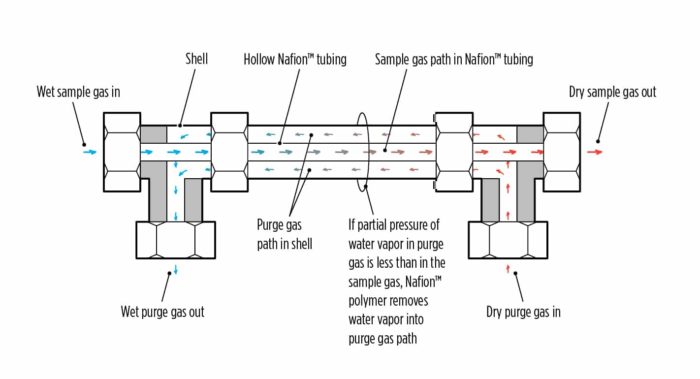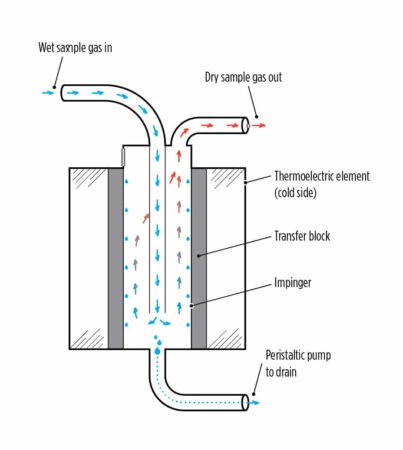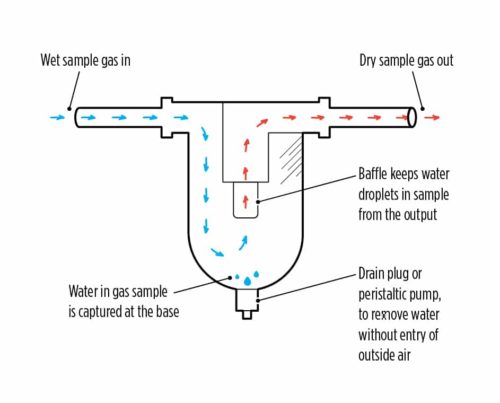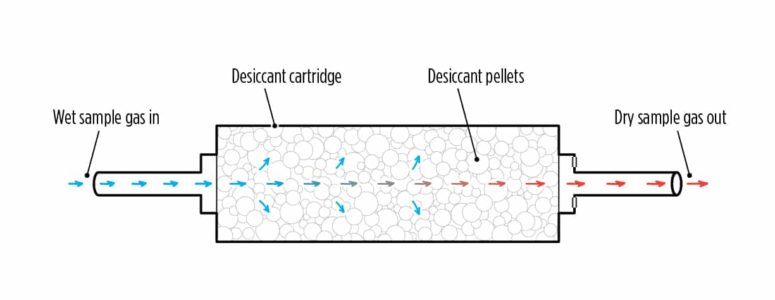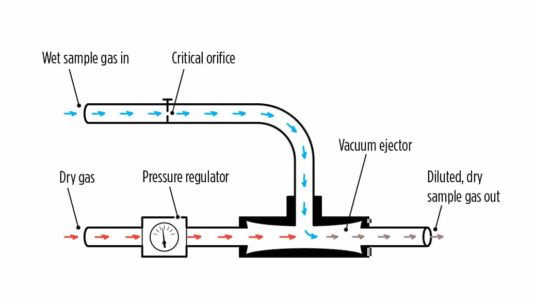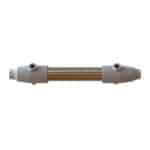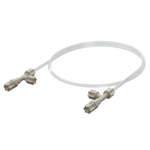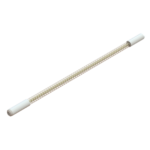A review and comparison of common methods to remove moisture from a gas for analysis.
Too much moisture in a gas being analyzed can decrease accuracy of the analysis, damage the gas analyzer, or both. To avoid this, a gas dryer is often used to dry the sample gas, before it is sent into the gas analyzer.
Some examples of applications where gas drying or dehumidification is needed include SOx and NOx monitoring and analysis, continuous emissions monitoring, process monitoring in oil and gas and chemical plants, ambient air monitoring, water quality testing (total organic carbon), and analyses in food safety, environmental and research applications.
This article will review why moisture can be a problem for gas analyzers, discuss the top gas drying options and finally, compare each option on key features.
We’ll review:
Why is moisture a problem in gas analysis?
Moisture affects accuracy.
Moisture can deplete signal-to-noise ratio (SNR) by collecting on the sensor or by blocking the signal from reaching the sensor. Depending on the sensor type, water contact also can cause damage over time. Additionally, water-soluble analytes can be dissolved in water present in the gas sample and fall out of the sample path and/or be drained away.
Moisture can damage the analyzer.
Moisture can damage electronics and, if corrosive elements are present in the gas sample, liquid acid can form which will further corrode components along the sample flow path.
Perma Pure MD-Series and PD-Series Gas Dryers
Perma Pure gas dryers are powered by Nafion™ tubing, which selectively removes water vapor from a gas sample. Because of Nafion™ polymer’s selectivity for water vapor, a Nafion™ dryer removes more moisture than other gas drying solutions while protecting analytes in the gas sample.
How It Works:
A Perma Pure dryer moves water vapor out of the sample gas stream and into a counterflowing purge gas using the partial pressure of water vapor to drive the exchange.
Purge gas should be instrument quality air (-40°C dew point) or nitrogen flowing at two to three times the sample flow rate. If no purge gas is available, there are other purge gas configurations that can be used, for example pulling vacuum through the purge path.
While the partial pressure of water in the purge gas is less than in the sample gas, Nafion™ polymer will selectively transfer water vapor from the sample gas across its membrane and into the purge gas flow to be swept away. At the sample gas outlet, water vapor has been removed from the sample to achieve humidity levels as low as –40 °C dewpoint.
| Pros | Cons |
|
|
Thermoelectric Cooler
Also called a Peltier cooler, Peltier chiller, chiller, or thermoelectric chiller, these systems cool a sample gas by chilling it and condensing-out the moisture.
How It Works:
A gas sample is sent through an impinger, which cooled by a Peltier module using the Peltier effect. Water in the gas sample condenses, and collects at the bottom of the impinger. Water collected in the impinger is drained away, perhaps using a peristaltic pump. This process of condensing-out the water in the sample yields a less humid gas sample at the output.
| Pros | Cons |
|
|
Water Trap
Also known as a moisture trap, these devices remove existing water droplets from a gas sample. They ‘trap’ the water, but do not remove water vapor from the sample, which may condense at a later point.
How It Works:
A gas sample is sent into the water trap. Any liquid water droplets in the sample will fall out due to gravity and collect at the bottom of the water trap. Before reaching the output, any excess water droplets in the gas stream will be caught by the baffle. At the output, the gas contains no liquid water. Water in the water trap can be drained by a peristaltic pump, or more commonly, by manually draining it after use.
| Pros | Cons |
|
|
Desiccant Dryer
Desiccants are hygroscopic materials that are used to remove moisture. Desiccant gas drying systems are essentially a cartridge filled with desiccant that a wet gas stream is passed through.
A wet gas sample is directed through the desiccant cartridge or desiccant canister. Inside, microporous ceramic beads (such as activated alumina, silica gel, molecular sieve, or another ceramic) will trap moisture in their voids, giving a drier sample gas at the output of the desiccant dryer.
While in operation, desiccants become progressively loaded with water, and must be periodically replaced or regenerated by heating the desiccant to evaporate the water.
| Pros | Cons |
|
|
Gas Dilution System
This gas drying system dilutes a wet gas sample with dry air, so the gas mixture that reaches the analyzer has less moisture content.
A wet sample gas is diluted by mixing in dry air, such as instrument quality air, to a particular ratio (typically around 25:75, sample gas to instrument air). The analyzer detects the analyte at lower levels but reports the actual value, which is a multiplication of the analyte level detected by the percent volume of sample gas in the mixture that entered the analyzer.
| Pros | Cons |
|
|
Feature Comparison of Gas Drying Methods
Browse Perma Pure Gas Drying Options
Contains multiple Nafion™ tubes, and thus is our dryer with the highest drying capacity. Recommended for flow rates up to 40 lpm.
Contains a single Nafion™ tube. Recommended for flow rates up to 4 lpm.
Including all gas dryers, and for CEMS applications, Baldwin Thermoelectric Coolers and sample conditioning systems.

